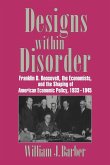More than any of his predecessors in the White House, Franklin D. Roosevelt drew heavily on the thinking of economists as he sought to combat the Great Depression, to mobilize the American economy for war, and to chart a new order for the post-war world. Designs Within Disorder is an inquiry into the way divergent analytic perspectives competed for official favor and the manner in which the President opted to pick and choose among them when formulating economic policies. During the Roosevelt years, two 'revolutions' were underway simultaneously. One of them involved a fundamental restructuring of the American economy and of the role government was to play in it. A second was an intellectual revolution which engaged economists in reconceptualizing the nature of their discipline. Most of the programmatic initiatives Roosevelt put in place displayed a remarkable staying power for over half a century.
Table of contents:
Preface; Introduction; 1. Stage-setting in the presidential campaign of 1932; 2. Curtain-raising in the first hundred days; 3. Deployments in the second half of 1933; 4. Rethinking the structuralist agenda (I): the fate of the National Recovery Administration, 1934-35; 5. Rethinking the structuralist agenda (II): the fate of the Agricultural Adjustment Administration, 1934-36; 6. Rethinking macro-economic strategies, 1934-36; 7. Shock tremors and their repercussions, 1937-38; 8. Toward a new 'Official Model,' 1939-40; 9. Designs for the management of an economy at war; 10. Designs for the post-war world; Epilogue.
Franklin D. Roosevelt drew heavily on the thinking of economists as he sought to combat the Great Depression, to mobilise the American economy for war, and to chart a new order for the post-war world. This book explains how divergent analytic perspectives competed for official favour and the manner in which Roosevelt opted to pick and choose among them when formulating economic policies.
This book explains how economists helped to give shape to the American economy during the years of the New Deal and the Second World War.
Table of contents:
Preface; Introduction; 1. Stage-setting in the presidential campaign of 1932; 2. Curtain-raising in the first hundred days; 3. Deployments in the second half of 1933; 4. Rethinking the structuralist agenda (I): the fate of the National Recovery Administration, 1934-35; 5. Rethinking the structuralist agenda (II): the fate of the Agricultural Adjustment Administration, 1934-36; 6. Rethinking macro-economic strategies, 1934-36; 7. Shock tremors and their repercussions, 1937-38; 8. Toward a new 'Official Model,' 1939-40; 9. Designs for the management of an economy at war; 10. Designs for the post-war world; Epilogue.
Franklin D. Roosevelt drew heavily on the thinking of economists as he sought to combat the Great Depression, to mobilise the American economy for war, and to chart a new order for the post-war world. This book explains how divergent analytic perspectives competed for official favour and the manner in which Roosevelt opted to pick and choose among them when formulating economic policies.
This book explains how economists helped to give shape to the American economy during the years of the New Deal and the Second World War.








